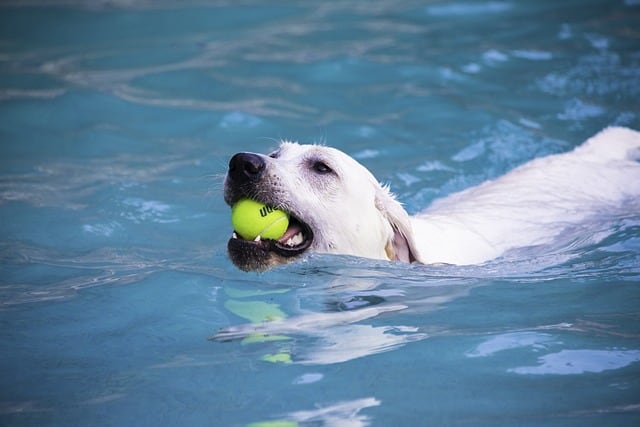Everything you need to know about the labrador
The Labrador Retriever is among the most beloved dog breeds in the world, and for a good reason. Labradors are known for their friendly and outgoing personalities, making them a popular choice for families and individuals. According to the American Kennel Club (AKC), the Labrador Retriever has been the most popular breed in the United States for 29 years.
Type
The modern labrador retriever is a descendant of the Newfoundland breed line. So, there are no precisely different labrador types. However, the labrador standards may differ from one breeder to another.
The American and English Lab are the two types with slight differences. The primary coat colors and temperament are the same as their intelligence levels.
Weight
The male labs are about 65-80 pounds, while the females are 55-70.
Height
The height of the male and female labradors are 22.5-24.5 and 21.5-23.5, respectively.
Family
The labradors initially spent time with their fishermen’s families. They spend the day with their owners (fishermen) retrieving fish. St. John’s dog is believed to be interbred with Newfoundland and local water dogs.
Area Of Origin
The labrador dog hails from Newfoundland island, Canada. They were popular as St. John’s dogs after Newfoundland’s capital city. Labradors’ price depends on many factors, but they are generally inexpensive.
Date Of Origin
Labs was a companion and helper to fishermen owners at the beginning of 1700. The St. John’s dog was first shipped to England around 1800. They are great in the field
Nature And Temperament: Ultimate Guide
Affectionate With Family
Labrador breeds are known for their caring nature and love of human companionship. They make great family pets and are very loyal and loving toward their family members.
Good With Young Children
Labrador Retrievers are known for their patience and gentle nature with children. They make great family pets and are affectionate and patient with kids, making them an excellent choice for families with young kids. They are a great companion for kids and are known to be good playmates.
Good With Other Dogs
Labrador Retrievers are generally good with other dogs and can get along well with other pets in the household. Proper socialization and training ensure they can interact well with other dogs and pets.
They are known to be friendly and outgoing, making them a good choice for people with other dogs in their households.
According to the American Kennel Club, they have a strong desire to be with other dogs and have a strong sense of pack mentality, which makes them great candidates for dog sports such as obedience and agility.
Shedding Level
Shedding level refers to how much a dog’s coat will lose hair. A labrador retriever has thick, fluffy coats with moderate shedding. It means they will shed a decent amount of hair year-round.
However, shedding levels can vary depending on the dog’s diet and care. That said, some Labradors may shed more than others.
Besides, pet owners can manage the coat with weekly brushing and grooming. It will help remove loose hair and prevent matting. You’ll also want to vacuum frequently or use lint rollers to pick up the hair they shed.
So if you’re planning to keep a Labrador as a pet, be ready for some shedding and regular grooming sessions. With the proper care and attention, you can keep the shedding under control and enjoy “PAWSOME” companionship with your new furry friend.
Coat Grooming Frequency.
Generally, vets recommend brushing your Labrador’s coat at least once weekly to keep it in good condition. However, the coat grooming frequency for a Labrador Retriever will depend on your pet’s coat type, i.e., short, medium, or long.
A Short-coated Labrador retriever requires minimal grooming. Hence, occasional brushing with a soft-bristled brush will suffice. Besides, medium-coated Labradors will require a bit more grooming. Ensure regular brushing using a slicker brush to remove any loose hair and keep the coat shiny.
Long-coated Labs will need the most grooming. So brush regularly with a slicker brush and a metal comb. It helps remove any tangles and matting.
Make sure you bathe your Lab only once a month or as needed. Frequent baths can strip the natural oils from their coat. Besides, watch for any signs of skin irritation, such as redness or itching. If you notice anything unusual, contact your vet immediately.
Drooling Level
The drooling level of Labrador Retrievers is considered to be low. They do not tend to drool excessively, making them a good choice for people not fond of dogs that drool a lot.
Coat Type
Labrador Retrievers have a double coat, which means they have a thick, soft undercoat and a waterproof topcoat. The undercoat is thick and soft, providing insulation for the dog in cold weather. On the contrary, the topcoat has coarser and longer hair. Also called a guard coat, the topcoat protects the dog from water and other elements.
Coat Length
The coat length in Labrador Retriever can vary depending on the individual dog and its genetics. Here’s a closer look at each coat type in a labrador retriever:

Short-coated Labrador Retriever:
These dogs have a coat close to the skin. The hair on their body is thick, which typically gives a shiny and sleek appearance. These are low-maintenance Labradors that shed less; hence require minimal grooming.
Medium-coated Labrador Retriever:
These dogs have slightly longer coats than short-coated Labradors. They have thick, medium-length hair on their body with a wavy or slightly curly texture. Since these Labradors shed moderately, they need regular brushing to maintain the coat.
Long-coated Labrador Retriever:
They have a coat that is longer and thicker than the other coat types. The hair on their body is long and feathery with a soft, silky texture. The long-coated labradors shed heavily and require frequent grooming to prevent matting. Besides, regular grooming keeps their coat healthy and tangle-free.
Openness To Strangers
Labrador Retrievers are known for their friendly and outgoing personalities, which makes them very open to strangers.
They are not naturally guarding dogs and typically greet strangers with wagging tails and friendly dispositions. However, proper training can help them be more aware of their surroundings and protective of their family members.
Playfulness Level
Known for their playful and energetic nature, a Labrador Retriever is always eager to play and have fun. Get some toys for Labs to have an active session with them. You can consider buying:
- Fetch toys: Labs love to play fetch. They happily chase after a ball, Frisbee, or stick.
- Chew toys: Labs are also heavy chewers, so providing them with durable chew toys is essential. It will keep them occupied for long hours.
These are also highly trainable dog breeds. Labs enjoy learning new tricks or participating in agility training. So include physical activities in their routine to keep them entertained. Here’re some great activities for your pet:
- Swimming: Labs are born swimmers. So let them enjoy a dip into a pool, lake, or ocean.
- Tug-of-war: labrador Retriever also enjoys playing tug-of-war with a rope or rubber toy.
- Hide and seek: Labs also like playing hide and seek. Make this game pleasurable by letting them look for treats or toys hidden around the house.
Remember, each dog has its preferences. So, experimenting with different toys and activities is always a good idea to see what your pet likes best.
Watchdog/Protective Nature
A labrador retriever is not known for their watchdog or protective nature. They are friendly and outgoing with strangers and may not be the best choice if you’re looking for a guard dog. However, proper socialization and training can help them be more aware of their surroundings and protective of their family members.
Adaptability Level
The Labrador Retriever is a highly adaptable breed known to adapt to all environmental factors. They are an excellent option for apartment or city living and for those with larger homes with yards. They are also adaptable to different climates and weather conditions, making them suitable for people living in other parts of the world.
Trainability Level
Labrador Retrievers are highly trainable dogs. They are intelligent and eager to please, which makes them quick learners. They respond well to positive reinforcement training methods and can be trained to do various tasks and tricks.
According to the American Kennel Club, they excel in obedience and agility training and are also commonly used as service and therapy dogs.
Energy Level
Labrador Retrievers have a high energy level and require regular exercise and playtime to stay happy and healthy.
They are highly active dogs that need plenty of mental stimulation to remain engaged and content. According to the American Kennel Club, They require at least 30-60 minutes of daily exercise to stimulate them physically and mentally.

Barking Level
A labrador retriever is a vocal breed that may bark in certain situations. The level of barking can vary based on various environmental factors, including personality, age, and training.
A Labrador Retriever may be more chatty than others, but that’s part of their unique personalities, like how some people are more talkative. Let’s talk about the barking habits of our beloved Labs, shall we? Typical situations where a Labrador Retriever may bark.
- Lack of physical activities
- When anxious or stressed
- When bored, excited, or wish to play
- Trying to protect their territory or family
- Hearing loud noises, such as thunder or fireworks,
If your Labrador’s barking becomes a nuisance, you can calm it in four ways. Indulge with them in some exercising and mental stimulation activities. Use positive reinforcement techniques to teach your dog to be quiet on command.
Make sure to establish clear rules and boundaries. Try to acclimate your dog to the noises that scare them, like playing thunderstorm recordings.
If nothing works, seek help from a professional dog trainer to understand their behavior and demands. Excessive, repetitive, and loud barking can indicate an underlying issue, such as separation anxiety or fear. So consult with a vet or trainer as soon as possible.
Barking is part of their charming personalities. So nothing to worry about! It’s not always the “woof woof woof” you hear at 2 am that’s waking you up. It could be their expression, “I’m excited to play!” or “I’m just a bit stressed; nothing but a belly rub can’t fix.” All in all, think of your pet’s bark as their little quirk. Remember the added security of having a guard dog that doubles as a cuddle buddy.
Mental Stimulation Needs
Two hours of daily exercise is necessary for your lab’s physical and mental stimulation. Considering their social nature, you can let them loose with other pets. It will give them quality workouts and mental stimulation. However, recall training is crucial for safety purposes.
What To Expect When Caring For a Labrador Retriever?
A labrador retriever loves being around family and should not be left alone for too long. A bored lab invites chewing and digging. A 30-min daily walk or a fetch game is a bare minimum. Lab’s good reputation must not be confused with no training.
Take care with proper training till your labrador retriever puppy is two years. Remember, they are happiest when they have something in their mouths, whether toys or treats.
Health
Labs are a healthy breed. While not all dogs experience these diseases, they are prone. Hip dysplasia, elbow dysplasia, cataracts, idiopathic epilepsy, myopathy, ear infections, cold tail, acute moist dermatitis, etc., are a few.
Breeders can use DNA tests for identification and prevention. Hip, elbow, ophthalmologist, and EIC DNA are recommended evaluation tests.
Grooming
Grooming isn’t just about making your dog look adorable (which they are by birth!). Instead, it’s about keeping them healthy and comfortable. Regular grooming will help keep your Labrador’s coat and skin in good condition. Besides, you can check for any lumps, bumps, or other signs of health issues before it’s too late.
Since this breed of dogs has thick, fluffy coats, they require routine attention to look and feel their best. It’s also a great way to strengthen the bond with your furry friend. So here’re some tips and suggestions to help you with your Labrador’s grooming needs:

1. Brush regularly:
Brushing your dog’s coat at least once a week will help to remove loose hair and prevent matting. A slicker brush or a pin brush are good choices for Labradors. A slicker brush removes tangles and mats, while a pin brush helps distribute natural oils throughout the coat.
2. Bathe occasionally:
A labrador retriever does not need frequent baths, but it’s a good idea to give them a bath every few months to keep their coat clean and shiny. A mild dog shampoo is best for their hair.
3. Trim the hair around their paws, ears, and tail:
Labradors have hair that can grow long around their paws, ears, and tail. Use scissors or clippers to trim the hair to a manageable length. Ensure to use scissors with rounded tips to avoid accidentally cutting your dog.
4. Clean ears:
A labrador retriever has floppy ears that can trap dirt and wax. Clean your dog’s ears once a month with a cotton ball or soft cloth dampened with a gentle ear cleaner.
5. Trim the nails:
Long nails can be uncomfortable for your dog and you both. So it’s vital to trim them when needed. Use professional dog nail clippers or trimmers to trim their nails.
6. Clean their teeth:
Regular tooth brushing is essential for your dog’s oral health. Make sure to use specifically designed dog toothpaste and a toothbrush.
7. Visit a professional dog groomer:
It’s also a good idea to take your Labrador to a professional groomer every 6 to 8 weeks. They can give your dog a haircut, trim their nails, clean their ears, and more. Let your pet look bow, wow!
Exercise
The labrador retriever breed comprises high-energy dogs. A two-hour daily exercise is a must-have on the owner’s list. Inadequate exercise often leads to hyperactive, destructive behavior and lack of soundness. A labrador retriever for hunters is awesome; this even goes for the golden retriever mix sometimes.

A labrador retriever can often get carried away; therefore, ensure they don’t overdo it. It is a crucial consideration when the joints are still growing in the puppy years. Labs are natural-born swimmers and love swimming as an exercise form. It is excellent for older or labs with joint issues.
Training
The eagerness to please nature makes them listen to commands and learn quickly. Early socialization and puppy training classes are vital to channel their high energy.
They best respond to positive reinforcement methods. Expose your lab puppy to different places, situations, and people when they are four weeks to seven months.
Early obedience training will result in a well-mannered adult lab. Recognize their behavioral issues by understanding their body language. They thrive best when adored and attended.
Nutrition And Feeding
A proper diet plays a crucial role in maintaining the well-being of a Labrador. Providing the daily nourishment requirement allows your pet to enjoy a long and healthy life. As a large and healthy breed, Labs have specific nutritional needs. Check out a complete feeding plan for Labradors.
Daily Intake Requirement,
The daily intake requirement for a Lab, will vary depending on the dog’s age, activity level, and overall health. An adult Labrador will require 2-3 cups of high-quality dry dog food daily, divided into two meals.
Right Food
A labrador retriever requires a diet high in protein, moderate in fat, and low in carbohydrates. Chicken, fish, and beef are good protein sources for your dog. To meet their daily fat requirement, include fish oil and flaxseed in their diet plan. Besides, ensure essential vitamins and minerals in their food, such as vitamin E and calcium.
Feeding Schedule
It’s best to feed adult Labradors twice a day. Once in the morning and once in the evening. However, 3-4 times daily is ideal for labrador Puppies under six months.
Nutrient Values
A diet for a Labrador should contain at least 18% protein and 5% fat. Feeding a diet with too much protein and fat can make an already obesity-prone labrador retriever dog, more obese
Usually, 1 cup of high-quality dry dog food is enough for breakfast. While for dinner, you can provide the Labradors 1-2 cups of nutritious dog food. Besides, you can offer healthy treats occasionally but in moderation to keep them engaged.
Wet and dry food can be good options when feeding Labrador if they suffice daily protein and fat needs. Moreover, the best choice depends on your dog’s preferences and needs.
High in moisture, wet foods help Labs stay hydrated. Besides, its softer texture and stronger flavor can appeal to picky eaters. On the other hand, dry meals are easy to store and convenient to serve. Thus, it’s also ideal if you’re planning to travel with your four-leg buddy.

Offer Fresh Water.
Encouraging them to drink water throughout the day helps this highly active dog breed stay hydrated. Make sure your pet drinks fresh, clean water.
Foods To Avoid For Labrador Retriever
- Onions and garlic, as they can be toxic to dogs
- Avocados, which can cause vomiting and diarrhea
- Grapes and raisins, which can cause kidney failure
- Tomatoes, which can cause stomach upset.
Like humans, dogs’ needs can also change over time. So occasionally try different homemade or store-bought dog meals to add new flavors to their eating regime. Of course, keep in mind the nutritional value! You can also consult your veterinarian to adjust the feeding plan as needed.
Further, closely monitor your dog’s weight and energy levels to ensure the diet plan suits its needs. Feeding a Labrador the right food in the right amounts is crucial to maintaining their overall health and preventing common health issues.
Kong
Choosing kong toys for your lab involves trial and error. The wide range of kong toys makes them an excellent asset. If you are tired of all the chew toys, kong can benefit your dog. Narrow the options based on the dog’s age, size, chewing habit, etc.
It is crucial to select a toy that fits the jaw size. You can choose from beginners, light, and aggressive chewers. They are explicitly designed for dogs’ chewing and playing needs. A few toy sizes are – small, medium, large, XS, XL, XXL, etc.

Famous Labradors
Labradors have been notable on the field. Check the compilation below –
Assistance Dogs: Breeds of Guide
Endal, a service dog, was the first to ride on the London Eye. He was also the first to work as a ‘chip and pin’ ATM card recipient of PDSA’s Gold Medal.
Sully is another assistance dog’s name who served alongside US President George Bush. Sully aided Bush in retrieving dropped items, opening and closing doors, supporting him while sitting or standing, etc., when Parkinson’s disease confined the president.
Police, Military, Water Rescue, And Detection Dogs
Frida, a yellow labrador, operated among search and rescue dogs for the Mexican Navy. Jake is another American black coat labrador serving in the rescue operations post-Hurricane Katrina.
Zanjeer worked as a detection dog in 1993 serial explosions in Mumbai. Lucky and Flo are twin detection labs that sniffled about 2 million counterfeit DVDs in 2007. They were also awarded Malaysia’s “outstanding service reward” for it. Sadie and Sasha were awarded the Dickin Medal for their devotion to military duty.
Pets
American President Bill Clinton’s Buddy and Seamus are popular labrador pets. Others include Vlamidir Putin’s ( Russian President ) Konni. Their suitability for field service was awesome.
The History of Labradors
Labradors were first noticed in Newfoundland, Canada. However, the true origin remains mysterious. The UK kennel club suggests their presence since 1500 alongside fishermen. The dogs were crucial in retrieving nets from the sea.
St. John’s, black water dogs, and Little Newfoundler are among its various names. Labrador Retriever was recognized as an official breed in 1903 by Kennel Club.
English Lab vs. American Lab: What’s the Difference?
A Labrador retriever is believed to be the descendant of the Newfoundland breed line. Most breeders follow the Kennel Club and American Kennel Club (AKC) for standardization. AKC recognized labradors in the US in 1917.
The terms American and English refer to the labrador style. The American is light-boned, less-bodied, and is common in field events. Simultaneously, the English lab has a broad head and muscular body. They are more or less the same, with slight differences.
American Lab
The American lab style is more high-energy. They are sleek, tall, and athletic. Ready to dive into the water any moment, you can take them hunting all day.
English Lab
English labs are stockier than their American counterparts. They are excellent retrievers for hunters lasting several days. The commonalities include the same primary coats, intelligence, temperament, blocky heads, etc.
Common Labrador Disease In Dogs
Labs are generally healthy but prone to gaining weight. They can overeat if not taken care of. Watch closely for a balanced diet and exercise. Here are a few diseases in dogs affecting labs.
Ear disorders +
Labs love water, which makes them prone to ear infections. Their ear canal can irritate with parasites, grass seeds, allergies, and infections. It leads to otitis or ear canal inflammation. The condition makes labs shake heads, flap their ears, and scratch them.
Elbow dysplasia +
Elbow dysplasia is usually hereditary and common in larger breeds. The condition develops when the elbow joint incurs abnormalities. It can worsen with the dog’s age and cause arthritis. Controlled exercise and surgery can help keep the dog active.
Lumps & bumps + ( Complex Diseases)
A labrador retriever can develop lumps and bumps in fat, skin, or muscle layers like other dogs. Abscesses, cysts, tumors, or lipomas, are some forms. Mast cells assist dogs in responding to trauma by releasing histamine.
The replication of these cells sometimes develops tumors. They are solitary lumps varying in size. While the treatment in most cases is surgery, it depends on size, location, and tumor type.
Arthritis Diseases
Arthritis is inflammation of joints. Labs can develop arthritis due to abnormal joints and wear and tear. They can feel stiff, unwilling to exercise, and move up and down the stairs. The condition cannot be cured but managed with weight control, anti-inflammatory, and stem cell therapies. Surgery is sometimes the long-term solution.
What To Know Before You Buy Or Rehome A Labrador Retriever?
- Labrador retriever is an intelligent breed ideal for older and young pet owners. Their easy adaptability and balanced temperament are the reasons.
- They are all missing the appetite-regulating POMC gene
- Labs shed too much, even with a short and soft coat. People with allergies must refrain.
- Labs were bred as working dogs. Hence, they are energetic and active. Two hours of exercise with mental stimulation is necessary daily.
- Socialization and puppy training are a must at early months of age. It will ensure they blend with others, including pets.
- Purchase from a reputable breeder or rescue organization. Third-party sellers are illegal.
- Labs can experience certain health conditions like hip or elbow dysplasia. Purchasing from a reliable breeder ensures genetic testing proof and a healthy dog.
Labrador Insurance Considerations
Labrador retrievers are prone to experience genetic disorders leading to arthritis. Check the limits while getting insurance for your labrador. Assess how long the conditions will be covered. It is essential to check the veterinary cover.

Hereditary conditions
Hereditary conditions are inherited or predisposed, like hip dysplasia. Look for insurance that caters to symptoms that didn’t show before the policy started.
Behavioral conditions
Separation anxiety or reactivity are behavioral problem types. Ensure the insurance covers therapy and drugs for these problems.
Congenital conditions
Conditions that exist from birth but do not reflect are congenital.
Dental illness & injury
Look for insurance covering dental injuries and illnesses. Annual dental veterinary checks are a must-have.
Cancer treatments
Insurance covering cancer will help your vet choose appropriate treatments. Your lab will benefit irrespective of the treatment, surgical, chemotherapy, radiation, or immunotherapy.
Physical & online consultations.
Some policies cover telephone, video, and face-to-face consultations. Choosing one gives you the flexibility of desired pet treatment.
Diagnostic tests
Insurance covering MRI, ultrasound, and CT scans can help in quick diagnosis.
Prescription medicine
You can also get covered for the medicines prescribed during illness. However, routine care may not be covered. It is best to check with your insurance provider.
Surgery & specialized care
Purchase insurance offering surgery cover for treatments like chemotherapy.
Physiotherapy & recovery therapies
Apart from surgeries, you can also seek coverage for acupuncture, chiropractic, and hydrotherapy.
Similar Dog Breeds
Undoubtedly, labs are America’s most beloved dog breed. However, not everyone finds this wonderful breed perfect. We’ve got you covered if you want to buy a breed similar to a labrador.
Chesapeake Bay Retriever.
The Chesapeake bay retriever is an American retriever with a waterproof coat. They are available in colors sedge, brown, or dead grass. High in energy, they weigh about 55 to 80 pounds. Their height stretches from 21 to 26 inches. They are loyal, sensitive, and affectionate family pets. They can be more aggressive, lasting 10 to 13 years.
Flat-Coated Retriever.
The flat-coated retriever is an excellent swimmer and bird dog. They have a medium coat and weigh about 60 to 70 pounds. Available in solid black coat and liver colors, they are highly energetic. They have a height between 22 to 24.5 inches. Their ever-wagging tail and friendly personality make them outstanding family dogs.
Curly-Coated Retriever.
Curly-coated retrievers are excellent retrievers for hunters. Their height is between 23 and 27 inches, and they weigh about 65 pounds. They are ideal family pets because of their general temperament. Eager to please, and children-loving, they are protective watchdogs.
Golden Retrievers
The golden retriever, is America’s most popular breed. Being intelligent, loyal, and friendly, they work as hunting, therapy, and family dogs. They weigh 55 to 75 pounds and are 21.5 to 24 inches tall. They have a water-repellant double coat and live for 10 to 12 years. The lustrous golden coat ranges from light golden to dark and reflects a golden labrador. Brush a few times a week to control shedding.
FAQs
Can a Labrador Retriever be left alone?
Labs should not be left alone for more than three hours. Lab puppies for even less to prevent separation anxiety. Leaving them alone for 8 hours or a day leads to anxiety and destruction.
Are Labradors aggressive?
Labradors are reportedly the least aggressive breed. While one may encounter an aggressive lab, it is not a characteristic.
What Is the Best Dog Food For Labrador Retriever Dogs & Puppies?
High-quality protein, whole grains, and fruits and vegetables are essential ingredients to look for in dog food for Labradors. Brands such as Blue Buffalo, Orijen, and Taste of the Wild are popular options.
What Is The Most Common Cause Of Death In Labrador Retrievers?
The most common cause of death in Labrador Retrievers is cancer.
Is a Labrador retriever High Maintenance?
Labradors require regular exercise and mental stimulation but are generally considered low maintenance regarding grooming and other care. Some owners may find that their high energy levels make them more demanding.